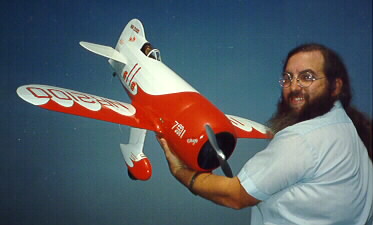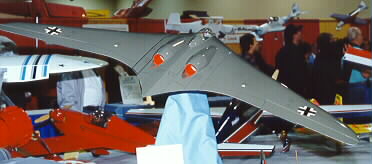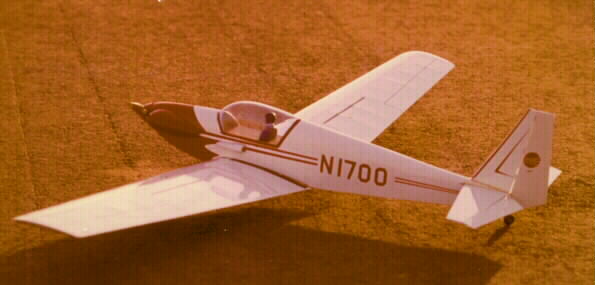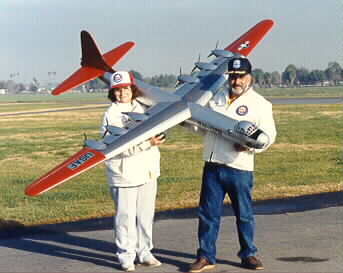Understanding Scale Speed
By Bob Boucher
The Technique of building beautifully detailed electric scale models
has advanced greatly in the past decade. Unfortunately we have all witnessed
the flight of under powered scale models whose performance can best be
described as a crash waiting to happen. Armed with the proper knowledge
we can avoid making these expensive mistakes. This paper will derive the
basic physical scaling laws which if followed will insure good flying behavior.
With proper scaling a model can be built that replicates the flying characteristics
of the original full size prototype. It will execute all maneuvers in scale
dimension. If you want to build your next scale model so that the model
will take off in scale runway length and wll perform a scale loop, and
fly at scale speed, then read on!

Keith Shaw with
his famous Gee Bee
Astro 25 Geared Motor with 14 cells
SCALE WEIGHT
If a construction drawing of a full size airplane was reduced in scale
and used to build a scale miniature from the very same materials as the
full size airplane, then all surface areas would be reduced by the SQUARE
of the scale factor and the thickness of all the materials would be reduced
by the scale factor. The net result would be that the Volume of materials
used and therefore the Weight of materials would be reduced by the Cube
of the dimension. This scaling law is expressed by rule 1.
RULE #1...The scale weight of the model should be equal to the
weight of the real airplane times the cube of the scale factor. For example
a Piper J-3 Cub weighs 1000 pounds and has a 36 foot wingspan. A six foot
model would be 1/6 scale and should weigh 1000/(6x6x6)=4.6 pounds to be
at scale weight. A Quarter Scale Cub should weigh 1000/(4x4x4)= 15.6 pounds.
The model may very well be built from different materials than the real
airplane, still the weight of the finished model should be scaled in conformity
with Rule #1.
SCALE WING LOADING
Since the wing area of the model is reduced by the square of the scale
factor while the weight of the model is reduced by the cube of the scale
factor it follows that the Wing Loading is directly proportional to the
scale factor. For example a quarter scale model will have a wing loading
of 1/4 that of the real airplane.
Rule #2..The wing loading of a model built to scale weight will
be reduced from that of the real airplane by the ratio of the scale factor.(The
quarter scale cub will have a wing loading of 20 ounces per square foot
instead of the 80 ounce wing loading of the real airplane)

Keith Shaws Horten Ducted Fan Flying
Wing
Twin Astro FAI-05 Motors and 18 cells
SCALE THRUST
The thrust to weight ratio of an airplane determines how long it takes
to accelerate to flying speed during take off, how steeply it can climb,and
how fast it can fly. If we want our model to fly like the real airplane
we need to make sure that the model has the same thrust to weight ratio.
That is the thrust of the model should be reduced by the same ratio as
the weight of the model. By applying Rule#1 we get Rule #3.
Rule #3...The thrust needed by the model airplane propeller is
equal to the thrust of the real airplane times the scale factor cubed.
For example the thrust required for a quarter scale model Cub needs to
be 1/64 the thrust of the full size airplane.
SCALE RPM
Assuming that our model in constructed to exact scale and therefore
is fitted with an exact scale size propeller, the question is what RPM
is required of our scale propeller to give us scale thrust? The thrust
of any propeller varies as RPM squared times Prop Diameter raised to the
fourth power. This means that as diameter is reduced the RPM must increase.
Rule #4...Scale Thrust requires the propeller RPM to be increased
by an amount equal to the square root of the scale factor. For example
if the 78 inch prop on the full size Cub spins at 2,000 RPM our quarter
scale cub needs to have its 19 inch propeller turning at 4,000 RPM to produce
scale thrust.
SCALE TIME
Another way of thinking about this RPM shift is to say that TIME has
been made to run faster in our model than it does in real life. The model's
clock is ticking at a faster rate than ours. This is an exact literal truth.
If a miniature clock were to be made exactly 1/4 scale it would tick exactly
twice as fast. This same scaling law causes the heart of a child to beat
much quicker than an adult, and the wings of a humming bird to beat much
faster than the wings of that of an eagle.
Rule #5...Scale time for the model is faster than real time for
the real airplane by an amount equal to square root of scale factor. This
relationship between scale time and real time is used by Hollywood camera
men to create realistic film footage of train wrecks, explosions, and other
disasters. They run their cameras at high speed and play the film back
at normal speed. This is known as slow motion and the effect is very realistic.

The Astro Flight Fournier RF-4 powered by an Astro 15 and
12 cells.
SCALE SPEED
Suppose our Piper J-3 Cub flies at 60 miles per hour (one mile a minute).
We want our quarter scale model to fly a scale mile in a scale minute.
Since the DISTANCE is divided by four but the TIME is divided by two, the
scale model will fly at one half the speed of the real airplane. Scale
speed for quarter scale model of a 60 mph J-3 cub is 30 miles per hour.
Like scale time, scale speed varies as the square root of the scale factor.
Rule #6...To fly at scale speed our model needs to fly slower
than the real airplane by an amount equal to the Square root of the scale
factor.
SCALE POWER
Before we can select the right motor and gear box for our electric scale
model we have to know how much torque will be needed to spin our scale
propeller at scale RPM so that it will produce the needed scale thrust.
The propeller is a transmission device that converts torque to thrust.
Propeller thrust is proportional to shaft torque and inversely proportional
to propeller diameter. Since the required thrust is proportional to the
model weight and therefore to scale factor cubed, the required motor torque
if proportional to scale factor raised to the fourth power. Power is torque
times RPM. Since RPM varies as the square root of scale factor, the horsepower
needed for the model airplane would be reduced from the horsepower of the
real airplane by the scale factor raised to the 7/2 power.. For example
if the real Piper Cub had a 65 horsepower engine, then our quarter scale
model of the cub would require about 1/2 HP.
Rule #7...The horsepower required of the motor in the model airplane
is less than the horsepower of the real airplane by the Scale factor raised
the 7/2 power.

Steve Johnson's Astro 60 powered Northrup Gamma
SCALE PERFORMANCE
In the first paragraph of this paper, I promised that if a model were
built to these scale rules then this model would have SCALE PERFORMANCE.
What I mean by scale performance is that the model would execute the same
maneuvers as the real airplane in scale dimensions. To prove this assertion
lets examine a few basic scale maneuvers.
SCALE TAKE OFF DISTANCE
In order to take off from the ground the real airplane must accelerate
to flying speed from a standing start. Since the thrust to weight ratio
of the model is the same as the real airplane, the acceleration of the
model will be the same as the acceleration of the real airplane. Scale
flying speed will be reached in scale time and therefore the model will
travel scale distance down the runway.
SCALE CLIMB ANGLE
Since the thrust to weight ratio of the model is the same as the thrust
to weight ratio of the real airplane, the climb angle for the model airplane
will be the same as the climb angle of the real airplane.
SCALE SIZE LOOPS
Both the propeller thrust to weight ratio and the wing lift to weight
ratio is the same for the model as for the real airplane. So all maneuvers
will be scale size. A quarter scale model will loop in one fourth the diameter
as the full size airplane. Since the scale clock in the model ticks faster
than in the real airplane things will happen faster in the model world
than in the real world. A quarter scale model will perform all its maneuvers
in one half the time required by the real airplane.

Addie and Tony Nacaratto with their
B-36
powered by Six Astro 05 motors and 36 cells.
Various Scale Factors
| Scale Factor |
1 |
1/4 |
1/5 |
1/6 |
1/10 |
| Wing Span |
100% |
1/4 |
1/5 |
1/6 |
1/10 |
| Weight |
100% |
1/64 |
1/125 |
1/216 |
1/1000 |
| Wing Loading |
100% |
25% |
20% |
16.7% |
10% |
| Air Speed |
100% |
50% |
45% |
41% |
31.6% |
| Time |
100% |
50% |
45% |
41% |
31.6% |
| RPM |
100% |
200% |
222% |
243% |
316% |
| Thrust |
100% |
15.6% |
0.8% |
0.46% |
0.1% |
| Power |
100% |
0.78% |
0.36% |
0.19% |
0.031% |
Example 2. North American P-51D
| Scale Factor |
1 |
1/4 |
1/5 |
1/6 |
1/10 |
| Wing Span |
37 ft |
111 in |
89 in |
74 in |
44 in |
| Weight |
7125 lb. |
111 lb. |
57 lb. |
33 lb. |
7.1 lb. |
| Wing Loading |
31 lb. |
123 oz |
99 oz |
82 oz |
49 oz |
| Air Speed |
437 mph |
218 mph |
196 mph |
179 mph |
135 mph |
| RPM |
2700 |
5400 |
5994 |
6561 |
8532 |
| Thrust |
3500 lb. |
55 lb. |
29 lb. |
16 lb. |
3.5 lb. |
| Power |
1695 hp |
13.2 hp |
6.1 hp |
3.2 hp |
0.61 hp |
These very high power military aircraft are very difficult to model
at scale speed. We have electric motors of up to two horsepower and gasoline
engines of over ten horsepower, but most modelers would find that flying
a model with a five pound per square foot or 80 ounce wing loading is like
holding a tiger by the tail. Most scale modelers prefer to build fighter
planes on the light side at about one half of scale weight and one half
of scale power.
Example 3. Piper J-3 Cub
| Scale Factor |
1 |
1/4 |
1/5 |
1/6 |
1/10 |
| Wing Span |
35 ft |
105 in |
84 in |
70 in |
42 in |
| Weight |
900 lb. |
14 lb. |
7.2 lb. |
4.2 lb. |
14 oz |
| Wing Loading |
5 lb. |
20 oz |
16 oz |
13 oz |
8 oz |
| Air Speed |
82 mph |
41 mph |
37 mph |
34 mph |
25 mph |
| RPM |
2350 |
4700 |
5217 |
5710 |
7426 |
| Thrust |
390 lb. |
6.1 lb. |
3.1 lb. |
1.8 lb. |
6.2 oz |
| Power |
65 hp |
0.51 hp |
0.23 hp |
0.12 hp |
0.02 hp |
The Astro 40 geared motor will power a one quarter scale 65 hp J-3 Cub
in a scale manner. Most modelers would prefer a bit more power and would
use the geared 40 on a one fifth scale model. Almost any light plane makes
a good scale subject. The scale models have very manageable wing loading
and low power requirements.
Example 4. Douglas DC-3
| Scale Factor |
1 |
1/6 |
1/8 |
1/10 |
1/12 |
| Wing Span |
95 ft |
190 in |
142 in |
114 in |
95 in |
| Weight |
16,289 lb. |
75 lb. |
31.8 lb. |
16.3 lb. |
9.4 lb. |
| Wing Loading |
16.5 lb. |
44 oz |
32 oz |
26 oz |
22 oz |
| Air Speed |
192 mph |
79 mph |
68 mph |
61 mph |
55 mph |
| RPM |
2100 |
5100 |
5940 |
6640 |
7275 |
| Thrust |
1,700 lb. |
7.8 lb. |
3.3 lb. |
1.7 lb. |
15 oz |
| Power |
850 hp |
1.6 hp |
0.59 hp |
0.26 hp |
0.14 hp |
|
